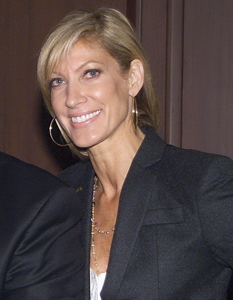After serving as a member of the Board of Directors of the Golden Gate Bridge, Highway & Transportation District for the past seven years, San Francisco’s Janet Reilly has been elected president of the board, which is responsible not only for the bridge, but also for the buses and ferries that carry North Bay passengers to and from San Francisco.

Janet Reilly was recently elected president of the Board of Directors of the Golden Gate Bridge, Highway & Transportation District after serving as a member for the past seven years. Photo courtesy of GGBHTD
By Wes Starratt, PE
Published: February, 2011
Janet Reilly is not only the wife of one of the City’s prominent political figures, Clint Reilly, but also has her own distinguished career in the political arena, as well as in television and public relations. She explained, “I hold a graduate degree in journalism from Northwestern University, and took my first job in TV at a station in Cheyenne, Wyoming.” But, soon, Janet answered the call that many in the media hear from California and “became involved with the campaign of Richard Riordan for mayor of Los Angeles, and when he won, I worked in his administration, which is where I met my husband.” She continued, “I moved to San Francisco in 1995 and took a job as a spokesperson for one of the local department stores. But, after I had my second child, I decided to stop working full time.
“Seven years ago, I was appointed by the San Francisco Board of Supervisors to the Golden Gate Bridge Board of Directors. It was an honor to serve on that board, and now, as its president, it is truly an honor. I take my responsibilities for this board incredibly seriously, and the entire board takes great pride in the bridge.”
Facing the Bridge’s Financial Issues
The last seven years have included difficult financial times—brought on by a downturn in the economy—that have resulted in reduced traffic on the bridge and lower ridership on the buses and ferries. In addition, the state has taken away several million dollars in subsidies, and the District was involved in making a $75 million contribution to the Doyle Drive reconstruction project.
Reilly stressed, “You need to remember that we have a 75-year-old bridge, and just maintaining it, apart from the extensive seismic work being done, is very expensive.” She explained, “The seismic retrofit program has been going on for close to nine years. We are at Stage 3A, with 3B marking the completion of the retrofit, which has amounted to a total of $700 million, including federal money.” Upon completion, bridge engineers stress that it will be stronger than when it was built.
Regarding the District’s financial plan, Reilly explained, “We re-assessed our mission and our priorities, and came up with a strategic financial plan to get us out of the deficit that we faced. Initially, in 2009, we had a five-year projected budget shortfall of $132 million, which is now down to $89 million, and involved some tough decisions.” Completed elements of the financial plan include increasing carpool and multi-axle tolls, reducing under-utilized bus service, freezing salaries, reducing administrative expenses, increasing fares on the ferries, and adjusting the 10-year capital plan. More remains to be done, including automated ticket vending machines installed at ferry terminals, possibly implementing all-electronic tolling on the bridge, and installing a movable lane-changing median barrier on the bridge. Thanks to the Metropolitan Transportation Commission (MTC), that barrier is fully funded at $25 million, and environmental studies are currently taking place.
Another bridge project is the suicide barrier. Reilly said, “I am a big proponent of the suicide barrier, and our board decided several years ago that we would have one installed. We have received some generous donations, including funding from the MTC; so, design work is currently underway. The barrier, which will cost some $50 million, will consist of a netting system underneath the roadway that will not affect the aesthetics of the bridge. “
Turning to the 75th Anniversary
Reilly spoke expectantly about the upcoming 75th Anniversary of the opening of the Golden Gate Bridge. “Of course, we have the 75th Anniversary of the bridge coming up, and we want to get the entire community involved, including the civil engineers who were so much a part of the 50th Anniversary.” (I had described to her the prominent role played by the American Society of Civil Engineers in organizing “Bridge Builders Day” for the 50th Anniversary.)
“It is wonderful to have this 75th Anniversary celebration to look forward to. I am the chair of the committee that is planning it. We are going to meet all groups involved, and especially the National Park Service, to come up with some creative ideas for a grand celebration on May 27, 2012.”

